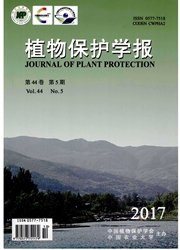

 中文摘要:
中文摘要:
通过人工接种诱发小麦条锈病,在病害大面积发生后,利用ASD手持式野外光谱仪(325~1075nm)测定小麦条锈病近地冠层高光谱数据,并获取该试验田同一时相SPOT-2卫星遥感数据,进而对卫星及近地小麦条锈病光谱反射率进行比较分析。结果显示,两者在SPOT-2卫星的3个波段上表现一致;1、2波段发病区的冠层光谱反射率分别为19.02%和15.40%,比对照区的18.61%和14.90%高,而在3波段中,发病区和对照区的反射率分别为34.65%和35.90%。由此可见,3波段发病区与对照区的光谱反射率差异更大,可用3波段进行小麦条锈病卫星遥感监测。
 英文摘要:
英文摘要:
Wheat in the experimental field was inoculated using stripe rust pathogen. When wheat stripe rust occurred, canopy reflectance of wheat was measured with an ASD field spectral handheld sensor, and corresponding SPOT-2 satellite remote sensing image at the same period was also obtained. The comparison of the reflectance between these both situations was conducted. The results showed that satellite and near-ground reflectance have the same rule in three bands of SPOT-2 satellite remote sensing spectrum on wheat stripe rust. For satellite remote sensing spectrum, the refleetances of diseased plot were 19.02% and 15.40% at the first band and the second band, respectively, and were higher than those in normal plot with the value of 18.61% and 14.90%. However, the refleetances in diseased plot and normal plot at the third band were 34.65% and 35.90%, respectively. It was indicated that the difference between the relectances in diseased plot and normal plot at the third band was more distinctively than those at the first band and the second band. Therefore, the third band of SPOT-2 satellite remote sensing spectrum can be used to monitor wheat stripe rust.
 同期刊论文项目
同期刊论文项目
 同项目期刊论文
同项目期刊论文
 期刊信息
期刊信息
